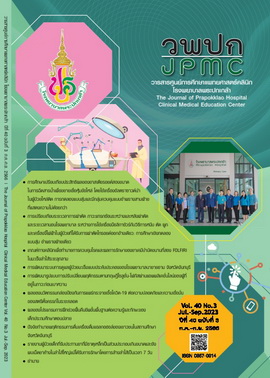ผลของโปรแกรมการฝึกช่วยฟื้นคืนชีพขั้นพื้นฐานต่อความรู้และทักษะของเด็กประถมศึกษาตอนปลาย
Main Article Content
บทคัดย่อ
ที่มาของปัญหา: การช่วยชีวิตขั้นพื้นฐานมีประโยชน์อย่างมากและสามารถช่วยลดการสูญเสียชีวิต ทรัพย์สิน หรือความพิการของผู้ป่วยได้ การช่วยชีวิตขั้นพื้นฐานได้อย่างรวดเร็วเป็นปัจจัยสำคัญอย่างหนึ่งที่สัมพันธ์กับการรอดชีวิตของผู้ป่วย เนื่องจากการกดหน้าอกส่งผลให้เกิดการไหลเวียนของเลือดและออกซิเจนไปเลี้ยงหัวใจและสมองควรทำทันทีโดยผู้อยู่ในเหตุการณ์
วัตถุประสงค์: เพื่อเปรียบเทียบความรู้ทั่วไปและความรู้ด้านทักษะการช่วยฟื้นคืนชีพขั้นพื้นฐานของเด็กประถมศึกษาตอนปลายของก่อนอบรมและหลังอบรม และศึกษาผลของโปรแกรมการช่วยฟื้นคืนชีพขั้นพื้นฐานต่อการพัฒนาความรู้และทักษะของเด็กประถมศึกษาตอนปลาย
วิธีการศึกษา: กลุ่มตัวอย่างเป็นนักเรียนประถมศึกษาตอนปลายโรงเรียนเทศบาล 2 (วัดศรีบุรีรตนาราม) และโรงเรียนเทศบาล 10 (อนุบาลเทศบาลเมืองสระบุรี) จำนวน 140 คน
ผลการศึกษา: 1) หลังการอบรมการช่วยฟื้นคืนชีพขั้นพื้นฐานมีคะแนนเฉลี่ยด้านความรู้ทั่วไป (t=2.05, p=0.04) และความรู้ด้านทักษะ (t=6.13, p<0.001) สูงกว่าก่อนอบรมอย่างมีนัยสำคัญทางสถิติ 2) หลังการอบรมการช่วยฟื้นคืนชีพขั้นพื้นฐานมีคะแนนเฉลี่ยทักษะการช่วยฟื้นคืนชีพขั้นพื้นฐานสูงกว่าก่อนอบรมอย่างมีนัยสำคัญทางสถิติ (t=13.07, p<0.001) 3) หลังการอบรมด้านความรู้เรื่อง CPR มีค่าเฉลี่ย 10.5±1.8 ความรู้ทักษะ CPR มีค่าเฉลี่ย 10.7±1.9 และด้านทักษะการช่วยฟื้นคืนชีพขั้นพื้นฐาน มีค่าเฉลี่ย 24.1±4.7
สรุป: พยาบาลสามารถนำโปรแกรมการฝึกช่วยฟื้นคืนชีพขั้นพื้นฐาน เพื่อส่งเสริมความรู้และทักษะของเด็กประถมศึกษาตอนปลายให้เหมาะสมต่อไป
Article Details

อนุญาตภายใต้เงื่อนไข Creative Commons Attribution-NonCommercial-NoDerivatives 4.0 International License.
เอกสารอ้างอิง
Ministry of Public Health, Department of Disease Control. Report 2021. Division of Injury Prevention; 2021.
Aramvanitch K, Sittichanbuncha Y, Tangkulpanich P,Tuangsirisup J. Learning outcomes of basic life support in primary school children (RAMAkids Club). Rama Med J 2019;42(1):29-35.
Berthelot S, Plourde M, Bertrand I, Bourassa A, Couture MM, Berger-Pelletier E, et al. Push hard, push fast: quasi-experimental study on the capacity of elementary schoolchildren to perform cardiopulmonary resuscitation. Scand J Trauma Resusc Emerg [Internet] 2013 [cited 2023 Mar 1];21(41). Available from : https://sjtrem.biomedcentral.com/articles/10.1186/1757-7241-21-41.
Sriklo M, Yujaiyen M, Sriamonruttanakul T. The effects of an education program promoting basic cardiopulmonary life support on knowledge and skills of basic cardiopulmonary life support of middle school students. Journal of Boromarajonani College of Nursing, Bangkok 2019;35:239-51.
Chaisongmuang P, Pearkao C. Effects of first aid to sudden cardiac arrest program for high-school students in northeast Thailand. Nursing Journal of the Ministry of public 2018;28(2):118-82.
Krongthaeo S, Partiprajak S, Udomkasemsah A. Effectiveness of the airway management and ventilation training program in undergraduate nursing students. Rama Nurs J 2016; 22: 93-110.
Association of Cardiologists of Thailand under the Royal Patronage of His Majesty the King. Basic life support guide and automatic external defibrillators (AEDs) for the public in 2018. Bangkok: The Association of Cardiologists of Thailand; 2018.
Hockenberry J, Wilson D. Wong's nursing care of infants and children. 10th edition. St. Louis: Elsevier; 2015.
Teerasong K, Wichianprapha T. The development of an instruction model for emotional intelligence of the fifth-year elementary students in Khlung district, Chanthaburi province. J Prapokklao Hosp Clin Med Educat Center 2021;38:285-92.
Bloom BS. Taxonomy of educational objectives: the classification of educational goals. London: Longman; 1956.
Laosuksri W, Wittayachamnankul B, Sutham K, Sruamsiri K, Rangsri W, Pongvuthitham R, et al. Efficacy of the new automated external defibrillator trainer and basic life support Manikin (Chiang Mai Model) in basic life support teaching in first-year medical students: a pilot study. J Prapokklao Hosp Clin Med Educat Center 2021;38:275-84.

